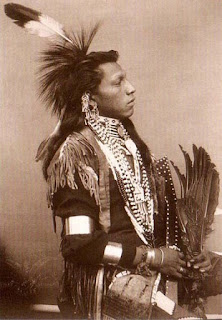Blackbird, the great chief of the Omahas. The account is given by George Catlin:
He requested them to take his body down the river to this his favorite haunt, and on the pinnacle of this towering bluff to bury him on the back of his favorite war-horse, which was to be buried alive under him, from whence he could see, as he said, “the Frenchmen passing up and down the river in their boats.” He owned, amongst many horses, a noble white steed, that was led to the top of the grass-covered hill, and with great pomp and ceremony, in the presence of the whole nation and several of the fur-traders and the Indian agent, he was placed astride of his horse’s back, with his bow in his hand, and his shield and quiver slung, with his pipe and his medicine bag, with his supply of dried meat, and his tobacco-pouch replenished to last him through the journey to the beautiful hunting grounds of the shades of his fathers, with his flint, his steel, and his tinder to light his pipe by the way; the scalps he had taken from his enemies’ heads could be trophies for nobody else, and were hung to the bridle of his horse. He was in full dress, and fully equipped, and on his head waved to the last moment his beautiful head-dress of the war-eagles’ plumes. In this plight, and the last funeral honors having been performed by the medicine-men, every warrior of his band painted the palm and fingers of his right hand with vermillion, which was stamped and perfectly impressed on the milk-white sides of his devoted horse. This all done, turfs were brought and placed around the feet and legs of the horse, and gradually laid up to its sides, and at last over the back and head of the unsuspecting animal, and last of all over the head and even the eagle plumes of its valiant rider, where all together have smouldered and remained undisturbed to the present day.

